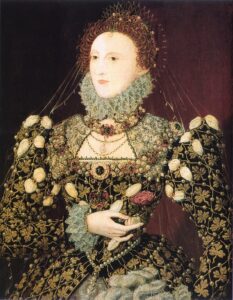
Her godson, Sir John Harington, wrote of her temper, saying, “When she smiled, it was a pure sunshine that every one did choose to bask in; but anon came a storm from a sudden gathering of clouds, and the thunder fell, in wondrous manner, on all alike.” Elizabeth reminds me of the words from a nursery rhyme I was told in my childhood: “When she was good, She was very good indeed, But when she was bad she was horrid.”
In an article on his biography of Elizabeth I, historian John Guy wrote “She was vain and courted flattery; she was jealous of her younger maids’ youth and beauty. She had a vicious temper, attacking one of them with her fists and breaking the girl’s finger. And she could swear volubly. Only the foolhardy approached her if she was in a foul mood.
Yet she could also be kind and generous. She fed Burghley with broth as he lay dying. She wrote gentle, consoling letters in her neatest writing to bereaved courtiers or their wives.”
Courtiers could bask in her sunshine, her favour, but they could also suffer her shouting, cursing and even violence.
Here are a few examples of her hot temper:
- Breaking one of her ladies’ fingers – Mary, Queen of Scots, in a letter to Elizabeth I, wrote of Elizabeth injuring Mary Scudamore (née Shelton) after she’d secretly married Sir John Scudamore. She wrote of Lady Talbot refusing to serve the queen “because she should be in fear, that when you was in wrath, you would do to her as you did to her cousin Skedmur, one of whose fingers you broke, and made those of the court believe that it was broken by a chandelier falling down from above.” Maid of honour Eleanor Brydges saw Elizabeth’s ill-treatment of Mary Scudamore, saying “She hath telt liberall bothe with bloes and yevell wordes, and hath not yet graunted her consent.”.
- Hurting a lady’s hand with a knife – Mary, Queen of Scots, also accused Elizabeth of attacking another lady who was waiting on her at table, saying that Elizabeth “gave her a great blow with a knife upon the hand.”
- Throwing a slipper – In March 1586, Elizabeth threw a slipper at Sir Francis Walsingham, her secretary and spymaster, after finding out from the master of a ship that had just arrived from Spain that he’d seen 27 Spanish galleons gathered at Lisbon, describing them as “floating fortresses. Walsingham had downplayed the threat and Elizabeth was livid. Ambassador Mendoza recorded her anger: “When the Queen heard this she turned to Secretary Walsingham, who was present, and said a few words to him which the shipmaster did not understand ; after which she threw a slipper at Walsingham and hit him in the face, which is not a very extraordinary thing for her to do, as she is constantly behaving in such a rude manner as this.”
- Boxing courtiers’ ears – In 1598, an angry Robert Devereux, Earl of Essex, quite forgot himself and turned his back on the queen. Elizabeth’s response to this rudeness was to box his ears and then “she bade him get him gone and be hang’d.” Unfortunately, the earl then put his hand on his sword, and the Lord Admiral had to step between queen and favourite to diffuse the situation.
- Stabbing tapestries – In 1601, Sir John Harington, Elizabeth’s godson, wrote of her depression and bad temper, recording that “the many evil plots and designs have overcome all her Highness’ sweet temper. She walks much in her privy chamber; and stamps with her feet at ill news; and thrusts her rusty sword at times into the arras in great rage.”
Sources
- Will the real Queen Elizabeth I please stand up? Historian John Guy uncovers the monarch behind the myth, by John Guy, Daily Mail, April 2016. https://www.dailymail.co.uk/home/you/article-3547576/Elizabeth-Historian-John-Guy-uncovers-monarch-myth.html
- “Letter from Mary, Queen of Scots, to Elizabeth, Queen of England, From the House of Lord Shrewsbury, at Sheffield, where she had long been a prisoner”, April 1584, transcribed in The Case of Mary Queen of Scots, and of Elizabeth Queen of England by Hugh Campbell, p. 254-257.
- Eleanor Bridges (Brydges) to the Earl of Rutland, 1576(?), The manuscripts of His Grace the Duke of Rutland: preserved at Belvoir castle, Volume I, p. 107.
- ‘Simancas: March 1586’, in Calendar of State Papers, Spain (Simancas), Volume 3, 1580-1586, ed. Martin A S Hume (London, 1896), pp. 569-573. British History Online http://www.british-history.ac.uk/cal-state-papers/simancas/vol3/pp569-573.
- The Historie of the most renowned and victorious princesse Elizabeth, late Queen of England by William Camden, p. 556.
- Letter from Sir John Harington to Sir Hugh Portman, Knight, in Memoirs of the Court of Elizabeth, Queen of England, ed. Lucy Aiken, Repr. of the 6th ed, p. 518.







